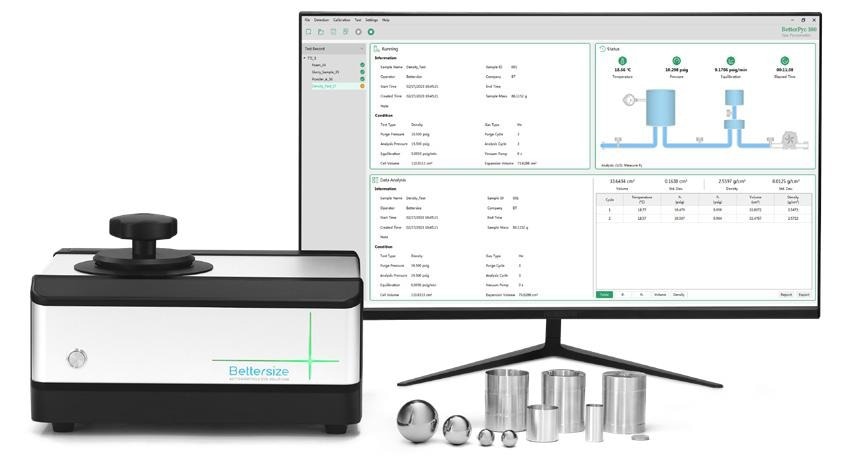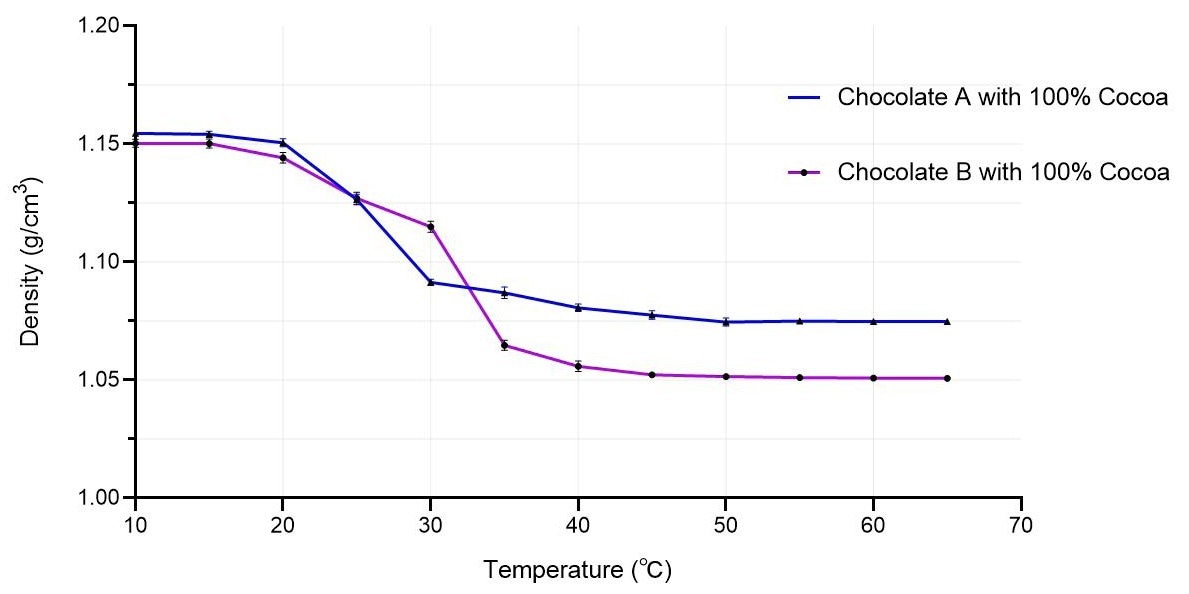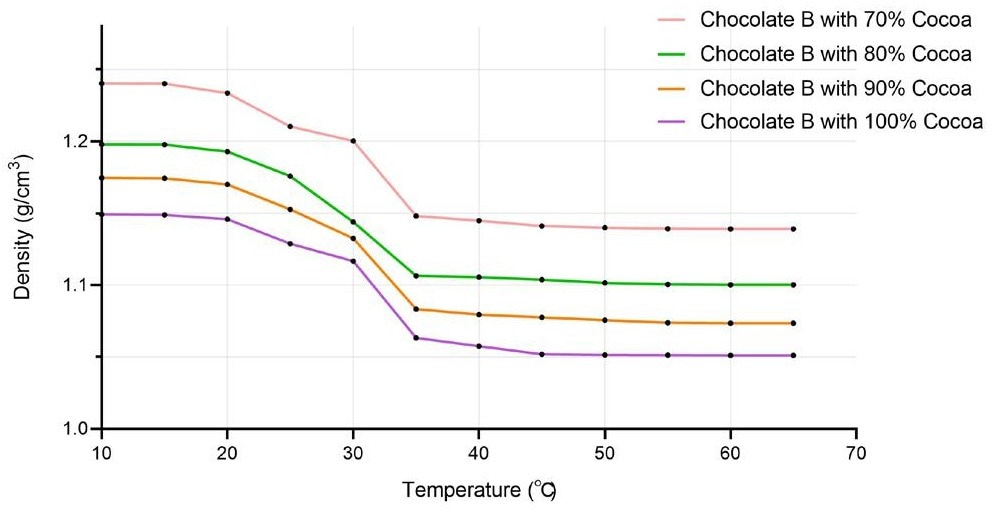This study underscores the significance of true density analysis in the optimization of chocolate manufacturing. The results show a consistent pattern of density variations across chocolates with different cocoa content, regardless of temperature.
The BetterPyc 380 gas pycnometer is designed to aid in the identification and control of this physical phenomenon, guaranteeing the quality of sweetness.

Image Credit: Bettersize Instruments Ltd.
Introduction
Temperature affects the density and, therefore, the texture and flavor of chocolate.
By understanding how density can change in varying temperatures, chocolate lovers can learn how to store chocolate, and chocolate manufacturers can ensure the consistency of every bite across different batches.
This knowledge helps them select the best ingredients and packaging to craft the finest chocolate imaginable.
This article explores how density shifts with temperature variations using the BetterPyc 380, an automatic gas pycnometer that serves as a dependable partner with its temperature control system.
Materials and Methods
This study aims to explore the true density variations in chocolates with differing cocoa content across various temperature ranges. The materials utilized comprise two commercially available chocolate brands: Chocolate A, containing 100% cocoa content, and Chocolate B is available in cocoa content variations of 70%, 80%, 90%, and 100%.
Utilizing the BetterPyc 380 in conjunction with the user-friendly EasyPyc software facilitates measurements across a temperature spanning from 10 °C to 65 °C, exhibiting an excellent repeatability of 0.05 °C.

BetterPyc 380 with EasyPyc Software. Image Credit: Bettersize Instruments Ltd.
Result and Discussion
From Warm to Chilly:
Figure 1 and Table 1 present the accurate density data for Chocolate A and B, both with 100% cocoa content. According to the results, the softening point of both samples is approximately 20 °C, representing the transition from a solid to a semi-solid state and the onset of shape distortion.
Chocolate A undergoes complete liquification at 30 °C, followed by a phase of minimal density fluctuations. In contrast, Chocolate B remains in a liquid state with no significant alterations beyond 35 °C.
Both samples exhibit comparable trends: as the temperature rises, chocolate density decreases due to a phase transition. However, this evokes one question: is chocolate density influenced by additional factors?

Figure 1. Density variation of chocolate A and B with 100% Cocoa in different temperatures. Image Credit: Bettersize Instruments Ltd.
Table 1. Density result of chocolate A and B, both with 100% Cocoa in the temperature range 10-65 ℃. Source: Bettersize Instruments Ltd.
| Sample (g/cm3) |
Temperature (℃ ) |
| 10 |
15 |
20 |
25 |
30 |
35 |
40 |
45 |
50 |
55 |
60 |
65 |
| Chocolate A |
1.1552 |
1.1550 |
1.1517 |
1.1249 |
1.0905 |
1.0887 |
1.0795 |
1.0763 |
1.0758 |
1.0755 |
1.0755 |
1.0755 |
| Chocolate B |
1.1490 |
1.1488 |
1.1458 |
1.1288 |
1.1166 |
1.0632 |
1.0574 |
1.0518 |
1.0514 |
1.0512 |
1.0511 |
1.0510 |
From Bitter to Sweet:
As highlighted in Figure 2 and Table 2, the density of chocolates also fluctuates with varying cocoa content. The melting points of Chocolate B, whether at 70%, 80%, 90%, or 100% cocoa content, closely align, indicating a similar phase transition pattern in line with the earlier conclusion.

Figure 2. Density variation of chocolate B with different cocoa contents in different temperatures. Image Credit: Bettersize Instruments Ltd.
Based on these findings, it can be inferred that, at the same temperature, chocolates with higher cocoa content typically have lower density and, consequently, less sweetness.
Both Chocolate A and Chocolate B share nearly identical melting points and phase transition processes. As they transition into liquid, their density decreases due to a phase change.
When the different cocoa levels of Chocolate B are explored, a new revelation emerges. At identical temperatures, an increase in cocoa content corresponds to a decrease in chocolate density. Thus, the more cocoa added, the more bitter the chocolate becomes and the less mass it holds.
These consistent trends across different chocolate brands highlight the universality of these findings, which are applicable to a broad spectrum of chocolates. This universality offers a foundational principle for improving chocolate production processes that consistently achieve optimal quality and texture.
Table 2. Density result of chocolate B with different cocoa contents in the temperature range of 10-65 ℃. Source: Bettersize Instruments Ltd.
| Sample (g/cm3) |
Temperature (℃ ) |
| 10 |
15 |
20 |
25 |
30 |
35 |
40 |
45 |
50 |
55 |
60 |
65 |
| 70% Cocoa |
1.2402 |
1.2401 |
1.2336 |
1.2103 |
1.2002 |
1.1480 |
1.1448 |
1.1410 |
1.1399 |
1.1391 |
1.1390 |
1.1389 |
| 80% Cocoa |
1.1978 |
1.1976 |
1.1927 |
1.1757 |
1.1439 |
1.1064 |
1.1055 |
1.1037 |
1.1015 |
1.1004 |
1.1002 |
1.1002 |
| 90% Cocoa |
1.1745 |
1.1743 |
1.1700 |
1.1526 |
1.1325 |
1.0823 |
1.0794 |
1.0774 |
1.0755 |
1.0738 |
1.0735 |
1.0734 |
| 100%Cocoa |
1.1490 |
1.1488 |
1.1458 |
1.1288 |
1.1166 |
1.0632 |
1.0574 |
1.0518 |
1.0514 |
1.0512 |
1.0511 |
1.0510 |
Conclusion
Through the application of BetterPyc 380, it was determined that melted chocolate has less density than solid chocolate and that increased cocoa content causes the chocolate to be bitter and lighter, influencing its texture and sensory qualities. These findings represent a universal truth inherent in all chocolate brands.
This discovery guarantees that your chocolate adventure is consistently delightful, no matter which brand you select.
Particle Detective: Hunting for Clues in Chocolate🍫🍫
Video Credit: Bettersize Instruments Ltd.

This information has been sourced, reviewed and adapted from materials provided by Bettersize Instruments Ltd.
For more information on this source, please visit Bettersize Instruments Ltd.
